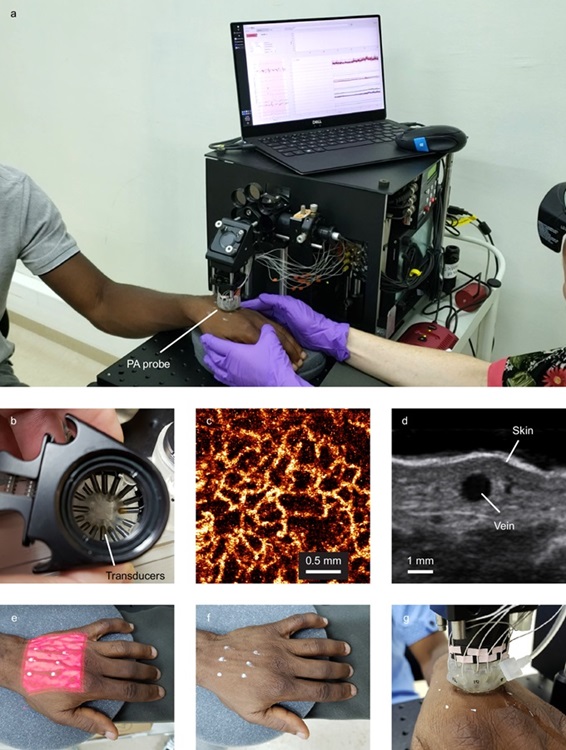Noninvasive Test Detects Malaria Without Blood Sample
|
By HospiMedica International staff writers Posted on 30 Oct 2024 |

Malaria remains a significant global health issue, with approximately 250 million cases and over 600,000 deaths reported annually. Nearly half of the world's population is at risk for malaria infection, particularly vulnerable groups such as children and pregnant women, who face the highest likelihood of severe illness and death from the disease. Currently, detecting this potentially fatal infection typically requires invasive blood samples, and existing testing methods have considerable limitations that hamper their effectiveness. A new technology now presents an exciting point-of-care (POC) diagnostic tool that has the potential to improve malaria detection and facilitate timely treatment.
Researchers at Yale School of Public Health (New Haven, CT, USA) and their collaborators have introduced a novel noninvasive test that could significantly transform malaria testing in low- and middle-income countries that are heavily impacted by this mosquito-borne illness. The innovative test does not require any blood samples, making it safer and more accessible. It utilizes a device called the Cytophone, which employs targeted lasers and ultrasound to identify malaria-infected cells in the bloodstream. Roughly the size of a tabletop printer, the Cytophone prototype can quickly ascertain the presence of malaria infection through a small, noninvasive probe applied to the back of a patient’s hand over a targeted vein.
The Cytophone's ability to detect infections noninvasively is made possible due to the accumulation of a by-product known as hemozoin in red blood cells infected with malaria parasites. This iron crystal by-product absorbs more light than normal hemoglobin when exposed to laser light, heating up and displaying magnetic and optical properties that the Cytophone probe can identify. In research published in Nature Communications, the team evaluated the Cytophone on 20 adult patients diagnosed with symptomatic malaria in Cameroon. The device successfully identified Plasmodium falciparum, the most prevalent and lethal malaria parasite, along with other less common species. The findings demonstrated that the Cytophone is sensitive enough to detect both high and low levels of parasites in infected blood, achieving 90% sensitivity and 69% specificity—comparable to, and in some cases exceeding, current gold standards for malaria testing that necessitate blood draws. Additionally, the device was capable of tracking the reduction of parasite levels when patients were retested post-treatment.
“Our study showed that the Cytophone was safe and had comparable diagnostic performance to current point-of-care options when compared to highly sensitive quantitative PCR as the gold standard,” said Jillian N. Armstrong, one of the study’s lead authors.
Channels
Critical Care
view channel
AI-Powered, Internet-Connected Medical Devices to Revolutionize Healthcare, Finds Study
A new study suggests that artificial intelligence (AI)-powered, internet-connected medical devices have the potential to transform healthcare by enabling earlier detection of diseases, real-time patient... Read more
Starfish-Inspired Wearable Tech Enables Smarter Heart Monitoring
Physical movement can make it challenging for current wearable devices to accurately track heart activity. Now, a starfish’s five-arm shape has helped resolve this issue. Inspired by the starfish's ability... Read moreSurgical Techniques
view channel
New Transcatheter Valve Found Safe and Effective for Treating Aortic Regurgitation
Aortic regurgitation is a condition in which the aortic valve does not close properly, allowing blood to flow backward into the left ventricle. This results in decreased blood flow from the heart to the... Read more
Minimally Invasive Valve Repair Reduces Hospitalizations in Severe Tricuspid Regurgitation Patients
The tricuspid valve is one of the four heart valves, responsible for regulating blood flow from the right atrium (the heart's upper-right chamber) to the right ventricle (the lower-right chamber).... Read morePatient Care
view channel
Portable Biosensor Platform to Reduce Hospital-Acquired Infections
Approximately 4 million patients in the European Union acquire healthcare-associated infections (HAIs) or nosocomial infections each year, with around 37,000 deaths directly resulting from these infections,... Read moreFirst-Of-Its-Kind Portable Germicidal Light Technology Disinfects High-Touch Clinical Surfaces in Seconds
Reducing healthcare-acquired infections (HAIs) remains a pressing issue within global healthcare systems. In the United States alone, 1.7 million patients contract HAIs annually, leading to approximately... Read more
Surgical Capacity Optimization Solution Helps Hospitals Boost OR Utilization
An innovative solution has the capability to transform surgical capacity utilization by targeting the root cause of surgical block time inefficiencies. Fujitsu Limited’s (Tokyo, Japan) Surgical Capacity... Read more
Game-Changing Innovation in Surgical Instrument Sterilization Significantly Improves OR Throughput
A groundbreaking innovation enables hospitals to significantly improve instrument processing time and throughput in operating rooms (ORs) and sterile processing departments. Turbett Surgical, Inc.... Read moreHealth IT
view channel
Printable Molecule-Selective Nanoparticles Enable Mass Production of Wearable Biosensors
The future of medicine is likely to focus on the personalization of healthcare—understanding exactly what an individual requires and delivering the appropriate combination of nutrients, metabolites, and... Read more
Smartwatches Could Detect Congestive Heart Failure
Diagnosing congestive heart failure (CHF) typically requires expensive and time-consuming imaging techniques like echocardiography, also known as cardiac ultrasound. Previously, detecting CHF by analyzing... Read morePoint of Care
view channel
Handheld, Sound-Based Diagnostic System Delivers Bedside Blood Test Results in An Hour
Patients who go to a doctor for a blood test often have to contend with a needle and syringe, followed by a long wait—sometimes hours or even days—for lab results. Scientists have been working hard to... Read more
Smartphone-Enabled, Paper-Based Quantitative Diagnostic Platform Transforms POC Testing
Point-of-care diagnostics are crucial for public health, offering rapid, on-site testing that enables prompt diagnosis and treatment. This is especially valuable in remote or underserved regions where... Read moreBusiness
view channel
Expanded Collaboration to Transform OR Technology Through AI and Automation
The expansion of an existing collaboration between three leading companies aims to develop artificial intelligence (AI)-driven solutions for smart operating rooms with sophisticated monitoring and automation.... Read more




















